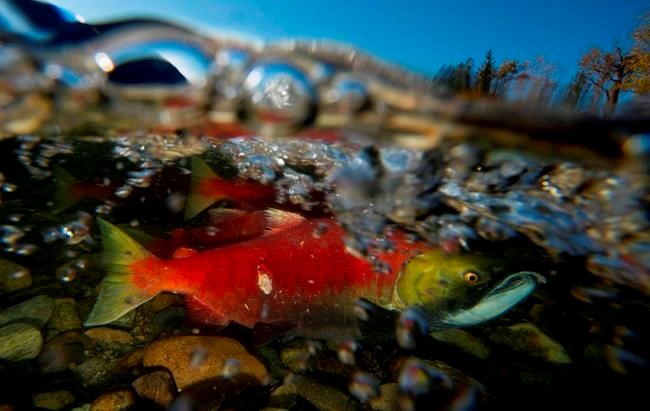The retreat of glaciers in the Pacific mountains of British Columbia and Alaska could produce thousands of kilometres of potential new salmon habitat, a study led by researchers at Simon Fraser University shows.
The study published Tuesday inNature Communications projects that more than 6,000 kilometres of new streams could be accessible to salmon by 2100,and just under one-third of that could be suitable for spawning.
Of the total kilometres of new streams that could be gained with "complete deglaciation," the study projects 23 per cent would be created by 2050.
To make the projection, researchers identified 315 glaciers at the headwaters of existing streams and linked their retreat with five different models of global climate change along withresearch of potential salmon habitat across 623,000 square kilometres of coastal B.C. and Alaska.
"What this illustrates is how some of these salmon ecosystems are being rapidly transformed by climate change," said Jonathan Moore, co-author of the study and a professor of biological sciences at the university. "While climate change poses dire challenges for salmon in many parts of their life cycle, it also might pose some opportunities in some locations."
The study cites earlier research that found a population of pink salmon grew to include more than 5,000 spawning adults within 15 years of a new stream and lake system emerging following glacier retreat in Glacier Bay, Alaska.
The researchers used modelling to "peel back the ice" for about 46,000 glaciers across Pacific mountain ranges, identifying 315 that feed streams with a suitable slope and flow for salmon,explained Kara Pitman, the study's lead author and a post-doctoral fellow at the university.
It projected that a further 3,300 kilometres of streams could be created by a total of 603 retreating glaciers with a somewhat higher threshold for stream slope. About half the glaciers in the study area are located in steep terrain that would be inaccessible to migratory salmon, particularly in B.C., it notes.
The analysis suggests the greatest gains in potential salmon streams would occur where large glaciers are located in low-slope terrain near the coast, with the highest increase of 27 per cent projected in the Gulf of Alaska.
The study notes that glacier retreat can also be associated with increased natural hazards that could affect salmon, such as floods and landslides.
The newly created streams would likely be quite cold with a lot of sediment, but over time, they could become productive salmon habitat, Moore said.
Salmon are very good at homing or finding their way to their usual spawning grounds, but between one and 10 per cent of a population may stray, he said.
"There are always salmon out there sort of exploring and looking for new habitat. And so those strays are going to be the ones that are finding the new systems," Moore said. The straying probably stems from the evolution of salmon in dynamic landscapes with constantly changing habitat, he added.
Fisheries and Oceans has said many salmon stocks in B.C. are declining to "historic lows" due to climate change, habitat loss and other threats.
"We can't underestimate the challenge that salmon face with climate change and multiple stressors," Moore said.
"But there are going to be some opportunities for salmon in some places, and I think by understanding those opportunities, we can really help steward systems the best ways possible into the future."
The study's findings help with understanding how ecosystems are changing as the climate warms, which could in turn help to guide decisions that affect how both existing and future salmon habitat is managed, Moore said.
It's much easier to protect than to restore, he noted.
Effectively protecting salmon involves "conserving not just their current habitat, but also avoiding the degradation of their future habitat," the paper says.
This report by The Canadian Press was first published Dec. 7, 2021.
Brenna Owen, The Canadian Press

